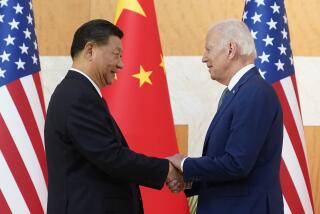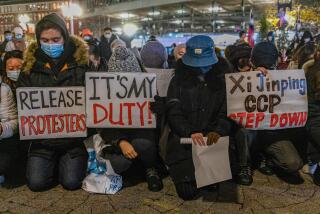Chinese Gulag
- Share via
For a decade the Chinese government has insisted that there are no political prisoners in China, that unlawful arrests and midnight interrogations and torture ended with the Cultural Revolution in 1976. That position was never credible: Chinese jails and prison camps may not be as crowded as they once were, but anyone who challenges the supremacy of the Communist Party or speaks too candidly to a foreigner is likely to be branded a counterrevolutionary and shipped off to prison, often without even a perfunctory trial.
The exact dimensions of the Chinese gulag have been impossible to measure, however. China’s extreme secrecy has made it hard for journalists to penetrate the system, and most foreign governments, including the United States, have been so eager to woo Chinese trade and strategic support that they have been reluctant to raise human-rights issues. It has been easier to accept China’s contention that widespread abuses were a thing of the past.
But a disquieting new study by Asia Watch offers proof that in Tibet, the most troubled corner of its kingdom, China still engages in “systematic human-rights abuses.” With chilling documentation, Asia Watch charges that the Chinese authorities in Tibet maintain a close surveillance of the entire population, discriminate against Tibetans in housing and education, brutally repress all political dissent, make arbitrary arrests and run prisons where “torture is part of the . . . routine.” Former prisoners have told Asia Watch that jailers usually use cattle prods on anyone who resists during “struggle sessions.”
To be sure, Tibet’s 2 million people have been a thorn in China’s side ever since they rebelled against Beijing’s rule in 1959. The People’s Liberation Army quickly put down the rebellion, but the Chinese Communist Party remains so sensitive about Tibetans’ continuing loyalty to the exiled Dalai Lama, the political and spiritual leader who fled to India just ahead of the liberation army,that even owning the traditional Tibetan flag is cause for arrest. Tibet’s best-known dissident, Geshe Lobsang Wangchuk, had been imprisoned almost continuously since 1962 for daring to write about the years in which Tibet was independent; blind and often tortured, he died in captivity in December, Asia Watch says.
China succeeded in shielding what happens in Tibet from the rest of the world until last Oct. 1, when Lhasa police officers fired on unarmed Buddhist monks and other demonstrators who chanted independence slogans and attacked a police station to free political prisoners; China acknowledged six deaths in the incident, though Western observers reported 14 dead. The Chinese promptly banned foreign journalists and most tourists from Tibet in an attempt to throw a veil around the region once again.
Both houses of Congress have denounced human-rights violations in Tibet, but the Reagan Administration’s response has been characteristically limp. First it applauded China’s efforts to restore order in Tibet, then it criticized the killings and in recent months has fallen silent again despite reports of continuing arrests. That silence is disturbing in an Administration so firmly committed to self-determination for the people of Central America. The danger is that, unless the Administration takes some concrete step like linking trade and improved bilateral relations with China to progress on human rights, the United States will lose whatever chance it has to affect events in Tibet. One may disagree with Tibetan dissidents’ demands for independence, as the United States does, and yet firmly believe that they should not be tortured for expressing them.
More to Read
Sign up for Essential California
The most important California stories and recommendations in your inbox every morning.
You may occasionally receive promotional content from the Los Angeles Times.













